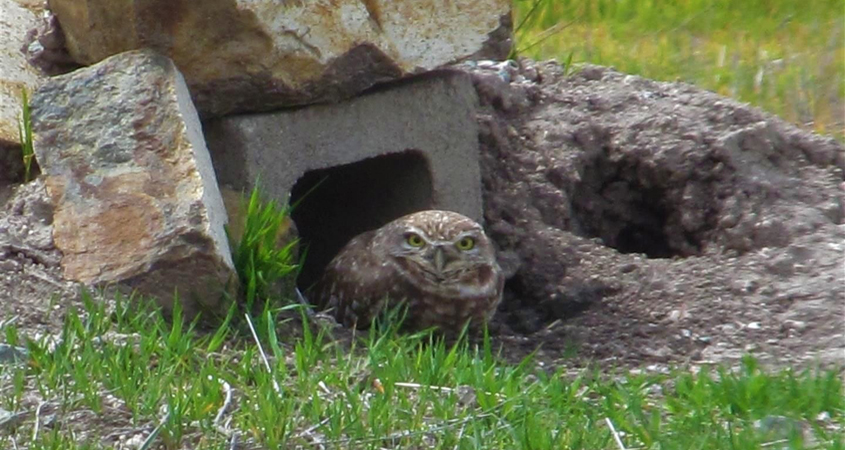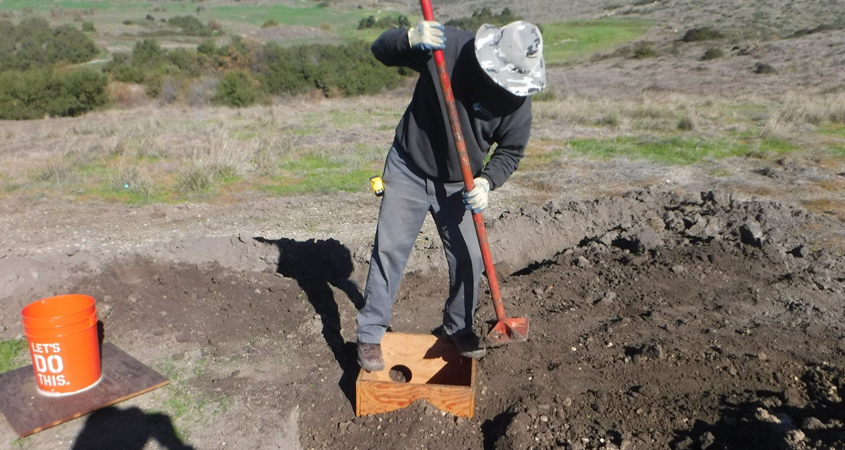Burrowing owl homes maintained by the Otay Water District received a modern makeover this year. As part of its ongoing environmental mitigation efforts, the District managed construction of new nesting burrows to encourage breeding.
Ten acres of the 240-acre, District-owned San Miguel Habitat Management Area reserve, or HMA, and mitigation bank in eastern Chula Vista is a dedicated native grasslands area where the new artificial burrows are located. The California Department of Fish & Wildlife has designated burrowing owls as a “Species of Special Concern.” They are also protected under the Federal Migratory Bird Treaty Act.

A burrowing owl in an old style burrow prior to remodeling. Photo: Otay Water District
In 2019 with CDFW’s guidance, the District began planning for the retrofit of existing artificial burrows and installation of several new burrows with the most current burrow design, intending to allow for maximized breeding success. The project also enhances the value of the native grassland habitat by removing invasive plants that surround most of the artificial burrows.
“The District’s project to enhance the existing burrowing owl habitat is so important because the HMA is a protected area where the owls can safely live and breed,” said Lisa Coburn-Boyd, Otay Water District environmental compliance specialist. “Increasingly, in San Diego County, the burrowing owl population is declining because of habitat loss and fragmentation.”
Small raptors active during the day
Burrowing owls are small owls with bright yellow eyes. Unlike other owls, burrowing owls are active during the day.
Burrowing owls are also quite social. This small raptor lives among others of its own species in loose groups of up to several hundred individuals. They measure seven to 11 inches long and weigh five to nine ounces. Their diet consists of insects, small rodents, amphibian and reptile species, and carrion.
Burrowing owls will take over old mammal burrows as their homes. But in areas where small mammals aren’t present, they will also nest in shallow, underground, human-made structures.
Burrowing owl homes remodeled using new design

This year, the Otay Water District used the updated burrow design recommended by the CDFW and developed by the San Diego Zoo Institute for Conservation Research. Photo: Otay Water District
Originally, the District constructed 15 artificial burrows in 2003 as mitigation for impacts to burrowing owl burrows due to reservoir construction and the creation of the former Salt Creek Golf Course. The original burrows used an older design of the artificial burrows and their native grasslands habitat. Although the HMA had regular burrowing owl visitors during that time, breeding success was limited with no owl breeding pairs.
This year, the Otay Water District used the updated burrow design recommended by the CDFW and developed by the San Diego Zoo Institute for Conservation Research. The District retrofitted and enhanced five existing burrows and installed six new burrows. During construction of the burrows in January and February, two burrowing owls seemed interested in the construction. No breeding pairs have used the burrows this season. The District hopes they will be back to move into the newly completed burrows.
See burrowing owls on the San Diego Safari Park’s live webcam.





